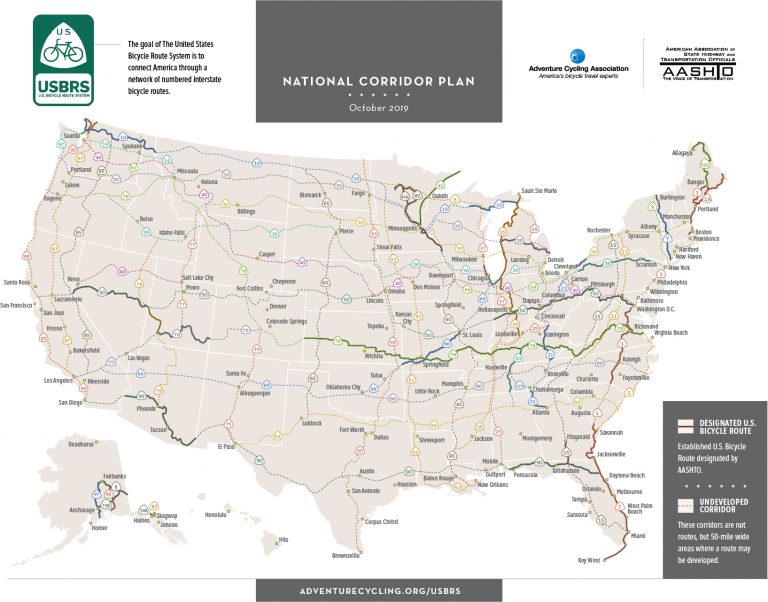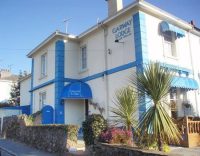14k miles of cycle routes
Over 300 new miles of U.S. Bicycle Routes are officially designated in West Virginia and Maine, following the October meeting of the American Association of State Highway and Transportation Officials (AASHTO).
With the designation of USBR 50, West Virginia becomes the 27th state to join the U.S. Bicycle Route System (USBRS). In Maine, USBR 501 connects cyclists to the far northern border with Canada. Together, the two new U.S. Bicycle Routes push the total mileage of the USBRS to over 14,000 miles.
“AASHTO’s annual designations to the U.S. Bicycle Route System support local economies and tourism by giving cyclists greater access to communities in urban, suburban, and rural areas of the country,” said Jim Tymon, Executive Director of AASHTO. “This year, West Virginia joined a growing list of states that have designated a bike route, and I see no reason why this trend won’t continue as the popularity of cycling continues to grow.”
The USBRS is a developing national network of officially recognized, numbered, and signed bicycle routes. All U.S. Bicycle Routes are designated by AASHTO. With the new designations, the USBRS now boasts 14,070 miles of routes in 27 states and Washington, DC. At least 40 states are currently developing U.S. Bicycle Routes.
Digital maps for all designated U.S. Bicycle Routes are available to the public for free, thanks to a partnership with Ride with GPS, from the Adventure Cycling website.
Adventure Cycling Association, a nonprofit that provides national coordination for the U.S. Bicycle Route System, partners with AASHTO to ensure states have the resources and expertise needed for successful route designation.
West Virginia
In West Virginia, USBR 50 crosses the state’s northern panhandle, closing a gap that connects Indiana and Ohio to Pennsylvania, Maryland, and Washington, DC.
“The approved route for USBR 50 in West Virginia is an important connection between Pennsylvania and Ohio, and this short section features low-volume rural roads, beautiful scenery, varied terrain, and the hospitable city of Weirton,” said Perry Keller of the West Virginia Department of Transportation.
Prior to designation, five potential route alignments were studied as options to extend USBR 50 from the Market Street Bridge in Steubenville, Ohio, to the Panhandle Trail at the Pennsylvania state line. A public meeting was held in September 2018 to present the alignments, and the approved route was selected because it provides the most direct connection to Ohio and Pennsylvania. It also provides shopping, food, and service opportunities for long-distance cyclists riding through Weirton.
“This designation puts the Northern Panhandle on the national map for bike touring, and connects West Virginia’s active transportation network with those of other states,” said Michael Paprocki of the Brooke Hancock Jefferson Metropolitan Planning Commission.
With this designation, U.S. Bicycle Route 50 runs continuously from Washington, DC, to the Indiana-Illinois border and will eventually connect all the way to San Francisco.

Maine
USBR 501 begins in Bangor, Maine, on the tide-influenced Penobscot River and ends at the Dickey Bridge on the St. John River in Allagash. The 327-mile route follows parts of the Katahdin Woods and Waters Scenic Byway and the St. John Valley Cultural Byway and passes near Maine’s fabled Mount Katahdin and the newly designated Katahdin Woods and Waters National Monument.
“The designation of U.S. Bicycle Route 501 in northern Penobscot and Aroostook counties will attract visitors to this largely rural region of Maine, showcasing a wide cross-section of Maine’s geographical, natural, historical, and cultural offerings,” said Jay Kamm, Senior Planner at Northern Maine Development Commission.
USBR 501 highlights the region’s cultural resources, including the Swedish Colony, numerous Amish communities of southern Aroostook, and the Acadian heritage of the St. John River valley. “It also highlights the importance of agriculture and forestry to the regional economy,” added Kamm.
































